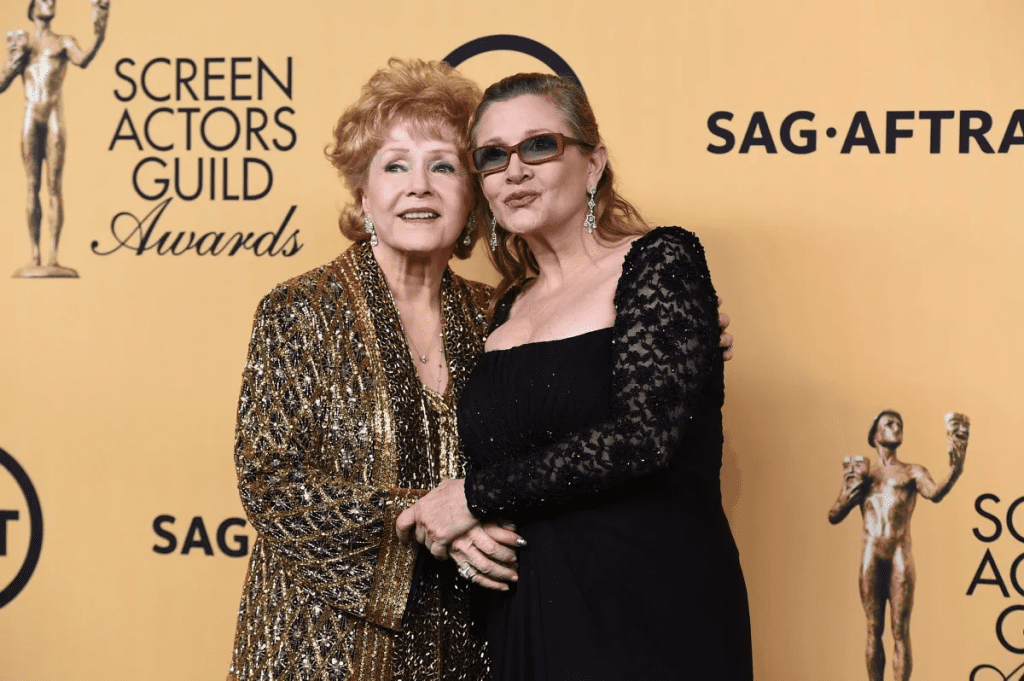Carrie Fisher, the legendary actress, writer, and comedian, captured hearts worldwide as Princess Leia in Star Wars. But her life story is far more layered than her iconic role. With stunning looks, unmatched charisma, and razor-sharp wit, Fisher became a cultural icon who navigated the highs of fame and the lows of personal struggles. Her journey is a testament to resilience, leaving behind a legacy that continues to inspire.
Born Into Stardom: Carrie Fisher’s Early Years

Carrie Frances Fisher was born on October 21, 1956, into Hollywood royalty. Her father, Eddie Fisher, was a celebrated singer, while her mother, Debbie Reynolds, was a beloved actress. Growing up in the spotlight, Fisher seemed destined for fame. However, her childhood was far from idyllic. At just two years old, her parents divorced, following her father’s highly publicized affair with Elizabeth Taylor.
Despite the turbulence, Fisher inherited her mother’s poise and charm, which became evident in her teenage years. She joined the Broadway revival of Irene at 15, sharing the stage with her mother and marking the beginning of her acting career. But behind the glitz, Fisher faced challenges that would shape her future.
Breaking Into Hollywood: The Early Roles
Fisher’s film debut came in 1975 with the satirical comedy Shampoo. While her role was small, it showcased her talent and set the stage for her meteoric rise. Around this time, Fisher briefly attended drama school in London, further honing her craft. But destiny had other plans for her.
In 1977, Fisher became a household name when she starred as Princess Leia in Star Wars: Episode IV – A New Hope. Her portrayal of Leia—a fearless, determined leader—cemented her status as a cinematic icon. The character’s distinctive hair buns and no-nonsense attitude left an indelible mark on pop culture.
The Star Wars Phenomenon
Fisher’s life changed overnight with the release of Star Wars. At just 19 years old, she was thrust into international stardom. Alongside co-stars Mark Hamill and Harrison Ford, Fisher became part of a franchise that would dominate the cultural landscape for decades.
The Star Wars sequels, The Empire Strikes Back (1980) and Return of the Jedi (1983), solidified her place in Hollywood history. Who could forget Leia’s daring rescue of Han Solo or her iconic appearance in the gold bikini? Yet, Fisher later revealed the personal cost of such fame. The pressures of being in the public eye, coupled with demanding film schedules, took a toll on her mental health.
Personal Struggles Behind the Scenes
Fisher’s life off-screen was as dramatic as her roles. She openly struggled with addiction, a battle that began during the filming of Star Wars. Fisher turned to drugs as a coping mechanism for the intense scrutiny and pressure she faced. In her memoir Wishful Drinking, she described this period with her trademark humor, offering a candid glimpse into her struggles.

Her romantic relationships also made headlines. Fisher dated musician Paul Simon, and the pair married briefly in 1983 before divorcing a year later. She was also briefly engaged to actor Dan Aykroyd, and later had a daughter, Billie Lourd, with talent agent Bryan Lourd. Through it all, Fisher remained resilient, using her wit and humor to navigate the complexities of her personal life.
A Multifaceted Talent: Beyond Acting
While Fisher is best remembered for her acting, her creative talents extended far beyond the screen. She became a prolific writer, penning novels, memoirs, and screenplays. Her semi-autobiographical novel Postcards from the Edge became a bestseller and was later adapted into a film starring Meryl Streep. The story drew from Fisher’s own experiences, blending humor with poignant reflections on addiction and recovery.
In addition to her novels, Fisher worked as a “script doctor” in Hollywood during the 1990s and 2000s, refining screenplays for films like Hook and Sister Act. Her sharp wit and keen storytelling made her a sought-after collaborator, further cementing her status as a creative powerhouse.
Candid Conversations About Mental Health

Fisher’s openness about her struggles with addiction and bipolar disorder was groundbreaking. At a time when mental health was still stigmatized, she used her platform to shed light on these issues. Her honesty and humor resonated with fans and helped foster greater understanding and acceptance.
In interviews and her writing, Fisher often described her life as a balancing act between chaos and creativity. She turned her challenges into stories that were both relatable and inspiring, showing that vulnerability can be a source of strength.
A Tragic Loss: The End of an Era
On December 27, 2016, the world lost Carrie Fisher after she suffered a heart attack on a flight. She was just 60 years old. The news of her passing sent shockwaves through Hollywood and beyond. Tributes poured in, celebrating her legacy as an actress, writer, and advocate for mental health awareness.

Her mother, Debbie Reynolds, tragically passed away the following day, a testament to their deep bond. Fisher’s daughter, Billie Lourd, continues to honor her mother’s memory, carrying forward the family’s artistic legacy.
Carrie Fisher’s Enduring Legacy
Carrie Fisher’s impact on Hollywood and pop culture is immeasurable. As Princess Leia, she became a symbol of strength and resilience. As a writer, she broke barriers with her honesty and humor. And as an advocate, she inspired countless people to confront their struggles with courage and grace.

Fisher once said, “Take your broken heart, make it into art.” This sentiment perfectly encapsulates her life. Despite her challenges, she used her experiences to create something meaningful, leaving a lasting legacy that continues to inspire.
Conclusion
Carrie Fisher was more than just Princess Leia—she was a beacon of charisma, wit, and authenticity. Her life, though marked by struggles, was a testament to resilience and creativity. From her groundbreaking role in Star Wars to her candid reflections on mental health, Fisher left an indelible mark on the world. Her story reminds us that true beauty lies in embracing both our strengths and our vulnerabilities.


